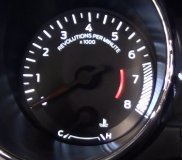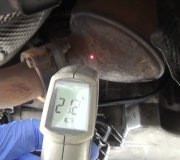Interestingly, VVT issues should be setting a code as well. Under normal condition, a P0010 or P0011 is set. I will provide the diagnostics for you regarding those codes. Hopefully it will help.
_________________________________________
2008 Chevy Truck Express 3500 V8-6.0L
P0011
Vehicle ALL Diagnostic Trouble Codes ( DTC ) Testing and Inspection P Code Charts P0011
P0011
DTC P0011
Diagnostic Instructions
* Perform the Diagnostic System Check - Vehicle prior to using this diagnostic procedure. See: Vehicle > Initial Inspection and Diagnostic Overview
* Review Strategy Based Diagnosis for an overview of the diagnostic approach.
* Diagnostic Procedure Instructions provides an overview of each diagnostic category.
DTC Descriptor
DTC P0011
- Camshaft Position CMP) System Performance
Diagnostic Fault Information
pic 1
Typical Scan Tool Data Table
pic 2
pic 3
pic 4
pic 5
Circuit/System Description
The camshaft position (CMP) actuator solenoid is controlled by the engine control module (ECM). The ECM sends a 12 volt, pulse width modulated (PWM) signal to the CMP actuator solenoid. The CMP actuator solenoid positions the CMP actuator spool valve to control the amount of pressurized engine oil, which enters into the CMP actuator assembly. A low reference wire circuit between the CMP actuator solenoid and the ECM completes the electrical circuit. The frequency of the pulse width modulated signal is fixed at 150 Hz. The ECM can only command the CMP actuator to retard the valve timing from the camshaft park position, or advance the valve timing back to the park position. The total range of valve timing command is 31 degrees as measured at the camshaft, or 62 degrees as measured at the crankshaft.
Conditions for Running the DTC
* DTC P0010, P0016, P0335, P0336, P0340, or P0341 is not set.
* The engine is running.
* The system voltage is between 9 and 18 volts.
* The CMP actuator is enabled.
* The power take off (PTO) is not active.
* The rate of change in the camshaft position is less than, 7.5 degrees for 3.35 seconds.
Conditions for Setting the DTC
* The ECM detects resistance greater than 2 ohms on the low reference circuit.
* The ECM detects that the CMP Angle position is more than 8 degrees difference than the Desired CMP position.
Action Taken When the DTC Sets
* DTC P0011 is a Type B DTC.
* The CMP actuator is commanded to the park position.
Conditions for Clearing the DTC
DTC P0011 is a Type B DTC.
Diagnostic Aids
This test procedure requires that the vehicle battery has passed a load test and is completely charged. Refer to Battery Inspection/Test. See: Starting and Charging > Component Tests and General Diagnostics > Battery Inspection/Test
Circuit/System Verification
1. Observe the engine oil level. The engine oil level should be within the operating range on the oil indicator stick.
2. Start the engine; allow the engine to reach normal operating temperature.
3. Monitor the engine oil pressure parameter value with the scan tool. The engine oil pressure must be at or above the minimum hot oil pressure values. Refer to Engine Mechanical Specifications (RPO LY2 VIN C) Engine Mechanical Specifications (RPO LMF VIN 4) Engine Mechanical Specifications (RPO LY6 VIN K).
4. Using the output control function of the scan tool, command the CMP actuator solenoid to 25 degrees. The CMP Desired parameter value should match the CMP Angle parameter value.
5. Observe the CMP Variance value, on the scan tool. The CMP Variance value will increment for several seconds, until the CMP Angle value matches the Desired CMP value. The CMP Variance value should then return to zero degrees.
6. Operate the vehicle within the Conditions for Running the DTC, to verify the DTC does not reset. You may also operate the vehicle within the conditions that are captured in the Freeze Fame/Failure Records Data List.
Circuit/System Testing
Important: You must perform the Circuit/System Verification first.
Important: Incorrect engine oil viscosity, aftermarket engine oil additives, or engine oil that overdue for changing, can greatly affect the performance of the camshaft actuator.
1. Ignition OFF, disconnect C112.
2. Test for less than 1 ohm between the low reference circuit ECM side, terminal E and ground.
If greater than 1 ohm, test the low reference circuit for an open/high resistance. If the circuit tests normal, replace the ECM.
3. Remove the water pump from the engine.
4. Inspect and test the remaining wire harness from C112 to the CMP solenoid for an open/high resistance, or a short to ground.
If the circuit tests normal, perform the component testing for the CMP actuator solenoid.
If the CMP solenoid and the circuit test normal, then refer to Camshaft Position Actuator Magnet Cleaning and Inspection and Camshaft Position Actuator Solenoid Valve Inspection. See: Engine > Overhaul
Component Testing
Static Test
Important: You must perform the Circuit/System Testing first.
Test for 5.9 and 6.9 ohms at 20°C (68°F) between the solenoid control terminal 2 and the low reference terminal 1 at the CMP actuator solenoid.
If the resistance is not within the specified range, then replace the CMP actuator solenoid. Refer to Camshaft Position Actuator Magnet Replacement.
Dynamic Test
Important: Do not allow electrical current to flow through the CMP actuator solenoid for more than 1-2 seconds, or damage to the solenoid may occur.
Point the CMP actuator solenoid vertically, towards a shop towel. Connect one end of a fused jumper wire to the CMP actuator solenoid control circuit terminal 2 and 12 volts. Connect a second jumper wire to the low reference circuit terminal 1 and momentarily connect to ground. The CMP actuator solenoid should immediately extend.
If the CMP actuator solenoid pintle does not extend, then replace the CMP actuator solenoid. Refer to Camshaft Position Actuator Magnet Replacement.
Repair Instructions
Perform the Diagnostic Repair Verification after completing the diagnostic procedure. See: A L L Diagnostic Trouble Codes ( DTC ) > Verification Tests
* Camshaft Position Actuator Magnet Replacement
______________________________________________________
Let me know if this helps.
Take care,
Joe
Images (Click to make bigger)
Saturday, September 5th, 2020 AT 6:16 PM








